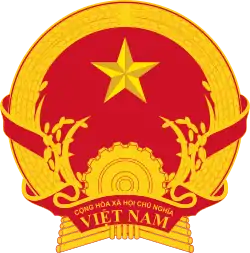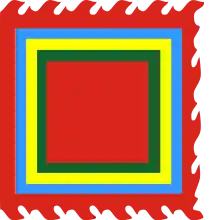Government of Vietnam
The Government of the Socialist Republic of Vietnam is the executive branch and body of the State of Vietnam. The members of the Government are appointed by the President of Vietnam on the advice of the Prime Minister of Vietnam, and approved by the National Assembly of Vietnam.
 | |
| Polity type | Unitary one-party socialist republic |
|---|---|
| Constitution | Constitution of Vietnam (2013) |
| Formation | 9 February 1945 (original) 7 February 1976 (current form) |
| Legislative branch | |
| Name | National Assembly |
| Type | Unicameral |
| Meeting place | National Assembly Building (Dien Hong Hall) at Ba Đình District, Hanoi |
| Presiding officer | Chairperson of the National Assembly |
| Executive branch | |
| Head of State | |
| Title | President |
| Head of Government | |
| Title | Prime Minister |
| Appointer | National Assembly |
| Cabinet | |
| Name | Government |
| Appointer | Prime Minister |
| Headquarters | Government Office at Ba Đình District, Hanoi |
| Judicial branch | |
| Supreme People's Court | |
| Seat | Supreme People's Court at Hoàn Kiếm District, Hanoi |
 |
|---|
| This article is part of a series on the politics and government of Vietnam |
|
|
Names
After the establishment of the Democratic Republic of Vietnam on 2 September 1945, based on 1945 Constitution the executive branch is called the Government (Chính phủ). The Government is headed by the President. Under the President is the Cabinet which is headed by the Prime Minister.
From 1959 to 1980, based on 1959 Constitution the executive branch is named as the Council of Government (Hội đồng Chính phủ). The Council of Government is headed by the Chairman (equivalent to the Prime Minister).
From 1980 to 1992, based on 1980 Constitution the executive branch is called the Council of Ministers (Hội đồng Bộ trưởng). The Council of Ministers is headed by the Chairman (equivalent to the Prime Minister).
From 1992 to now, based on 1992 Constitution the executive branch is renamed as the Government (Chính phủ). The Government is headed by the Prime Minister.
History
Council of Ministers (1980–1992)
The Vietnamese Council of Ministers was entrusted by the 1980 Constitution with managing and implementing the governmental activities of the state.[1] It is described in that document as "the Government of the Socialist Republic of Vietnam, the highest executive state body of the highest body of state authority." It is accountable to the National Assembly of Vietnam, and, more directly, to the Vietnamese Council of State when the National Assembly is not in session. Its duties include submitting draft laws, decrees, and other bills to the National Assembly and the Council of State; drafting state plans and budgets and implementing them following the National Assembly's approval; managing the development of the national economy; organising national defence activities and assuring the preparedness of the armed forces; and organising and managing the state's foreign relations. Its membership includes a chairman, vice-chairman, cabinet ministers, and the heads of state committees, whose terms of office coincide with that of the National Assembly. The Council of Ministers includes its own standing committee, which serves to co-ordinate and mobilise the council's activities. In 1986 the standing committee was expanded from ten to thirteen members.
Each ministry is headed by a minister, who is assisted by two to twelve deputy ministers. The number and functions of the ministries are not prescribed in the Constitution, but in 1987 there were twenty-three ministries and a number of other specialised commissions and departments. In an apparent response to the call by the Sixth National Party Congress in 1986 for a streamlined bureaucracy, several ministries were merged. The former ministries of agriculture, food, and food industry were joined in a newly created Ministry of Agriculture and Food Industry. The ministries of power and mines were merged to form the Ministry of Energy, and a newly created Ministry of Labour, War Invalids, and Social Welfare consolidated the duties of three former ministries. The addition of two new ministerial bodies also resulted from the 6th National Party Congress: a Ministry of Information to replace the Vietnam Radio and Television Commission, and a mission for Economic Relations with Foreign Countries to act as a co-ordinating body for foreign aid.......................................
Government (since 1992)
The current Government of Vietnam consists of 18 ministries, 4 ministry-level agencies and 11 other government-dependent agencies.
18 Ministries (Bộ), each is headed by a Minister (Bộ trưởng):
- Ministry of Foreign Affairs (Bộ Ngoại giao)
- Ministry of Defence (Bộ Quốc phòng)
- Ministry of Public Security (Bộ Công an)
- Ministry of Home Affairs (Bộ Nội vụ)
- Ministry of Justice (Bộ Tư pháp)
- Ministry of Finance (Bộ Tài chính)
- Ministry of Industry and Trade (Bộ Công thương)
- Ministry of Planning and Investment (Bộ Kế hoạch và Đầu tư)
- Ministry of Agriculture and Rural Development (Bộ Nông nghiệp và Phát triển Nông thôn)
- Ministry of Construction (Bộ Xây dựng)
- Ministry of Transport (Bộ Giao thông Vận tải)
- Ministry of Education and Training (Bộ Giáo dục và Đào tạo)
- Ministry of Science and Technology (Bộ Khoa học và Công nghệ)
- Ministry of Natural Resources and Environment (Bộ Tài nguyên và Môi trường)
- Ministry of Information and Communications (Bộ Thông tin và Truyền thông)
- Ministry of Health (Bộ Y tế)
- Ministry of Labour, Invalids and Social Affairs (Bộ Lao động - Thương binh và Xã hội)
- Ministry of Culture, Sports and Tourism (Bộ Văn hóa, Thể thao và Du lịch)
4 ministry-level agencies:
- Government Office (Văn phòng Chính phủ), headed by a Chief (Chủ nhiệm)
- Government Inspectorate (Thanh tra Chính phủ), headed by an Inspector-General (Tổng Thanh tra)
- State Bank of Vietnam (Ngân hàng Nhà nước Việt Nam), headed by a Governor (Thống đốc)
- Committee for Ethnic Minority Affairs (Ủy ban Dân tộc), headed by a Chief (Chủ nhiệm)
11 other government-dependent agencies:
- Vietnam Television or VTV (Đài Truyền hình Việt Nam), headed by a General Director (Tổng Giám đốc)
- Vietnam News Agency or VNA (Thông tấn xã Việt Nam), headed by a General Director (Tổng Giám đốc)
- Voice of Vietnam or VOV (Đài Tiếng nói Việt Nam), headed by a General Director (Tổng Giám đốc)
- Commission for the Management of State Capital at Enterprises or CMSC (Ủy ban Quản lý vốn Nhà nước tại doanh nghiệp), headed by a Chairperson (Chủ tịch)
- Ho Chi Minh National Academy of Politics (Học viện Chính trị Quốc gia Hồ Chí Minh), headed by a President (Giám đốc)
- Ho Chi Minh Mausoleum Management (Ban Quản lý Lăng Chủ tịch Hồ Chí Minh), headed by a Chief (Trưởng ban)
- Vietnam Social Security (Bảo hiểm Xã hội Việt Nam), headed by a General Director (Tổng Giám đốc)
- Vietnam Academy of Social Sciences (Viện Hàn lâm Khoa học Xã hội Việt Nam), headed by a Chairperson (Chủ tịch)
- Vietnam Academy of Science and Technology (Viện Hàn lâm Khoa học và Công nghệ Việt Nam), headed by a Chairperson (Chủ tịch)
- Vietnam National University, Hanoi (Đại học Quốc gia Hà Nội), headed by a President (Giám đốc)
- Vietnam National University, Ho Chi Minh City (Đại học Quốc gia Thành phố Hồ Chí Minh), headed by a President (Giám đốc)
Current government members (2016-2021)
The current Government is appointed by the President and approved by the National Assembly in 2016 after the 2016 legislative election. The term length for each government is 5 years and renewable. This Government is expected to end before the 2021 legislative election.
The heads of other government-dependent agencies are appointed by the Prime Minister without approval by the National Assembly. Usually there is no term limit on the leaders of those agencies. The current heads of the government-dependent agencies are:
- General Director of Vietnam Television: Trần Bình Minh
- General Director of Vietnam News Agency: Nguyễn Đức Lợi
- General Director of Voice of Vietnam: Nguyễn Thế Kỷ
- Chairman of Commission for the Management of State Capital at Enterprises: Nguyễn Hoàng Anh
- President of Ho Chi Minh National Academy of Politics: Professor Nguyễn Xuân Thắng
- Chief of Ho Chi Minh Mausoleum Management: Major General Bùi Hải Sơn
- General Director of Vietnam Social Security: Nguyễn Thế Mạnh
- Chairman of Vietnam Academy of Social Sciences: Associate Professor Bùi Nhật Quang
- Chairman of Vietnam Academy of Science and Technology: Professor Châu Văn Minh
- President of Vietnam National University, Hanoi: Associate Professor Nguyễn Kim Sơn
- President of Vietnam National University, Ho Chi Minh City: Associate Professor Huỳnh Thành Đạt
References
- "Vietnam - Government and society". Encyclopedia Britannica. Retrieved 5 January 2021.
- "Vietnam PM appoints acting health minister". VietReader Viet Nam.

